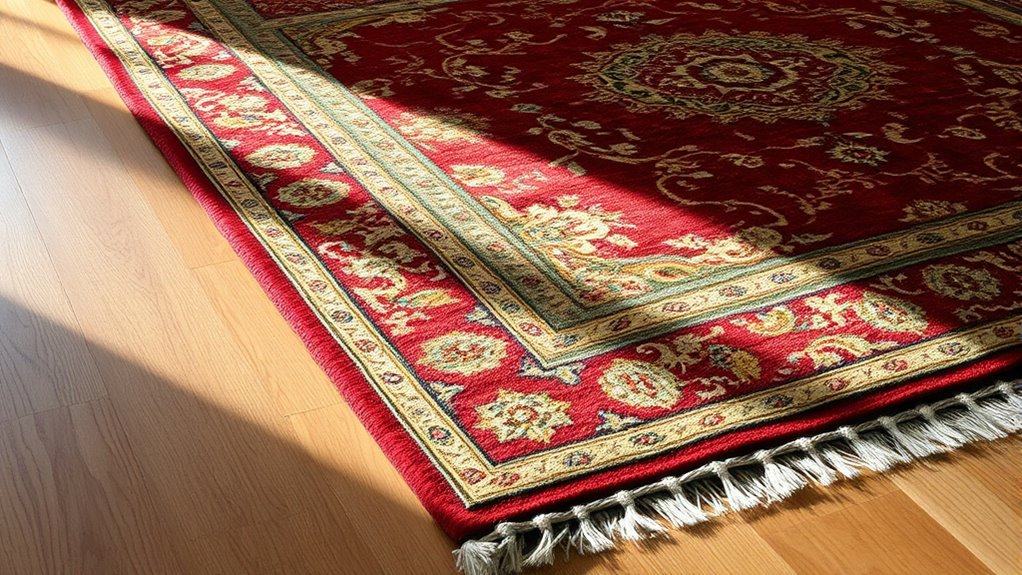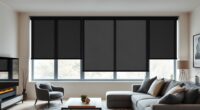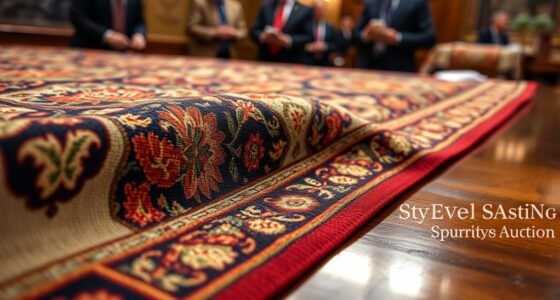To photograph rugs for online resale, start by thoroughly cleaning and inspecting your rug, repairing any damages. Use natural daylight or soft, diffused indoor lighting to show true colors and textures. Choose a neutral background and frame the rug to capture its full design, shooting from multiple angles including close-ups and wide shots for scale. Pay attention to glare and reflections, and enhance your images with careful editing for color accuracy. Keep exploring for more tips to make your rugs stand out online.
Key Takeaways
- Use natural, diffused lighting to accurately capture rug colors and textures, avoiding harsh shadows and glare.
- Clear the rug thoroughly and inspect for damages, ensuring it looks pristine and well-maintained before photographing.
- Capture multiple angles—top-down, side, and close-up—to showcase patterns, fibers, and craftsmanship details.
- Include styled room shots with furniture or natural elements to demonstrate scale and real-life placement.
- Edit images for brightness, contrast, and color accuracy, cropping out distractions for a polished, professional presentation.
Preparing Your Rug for the Photoshoot
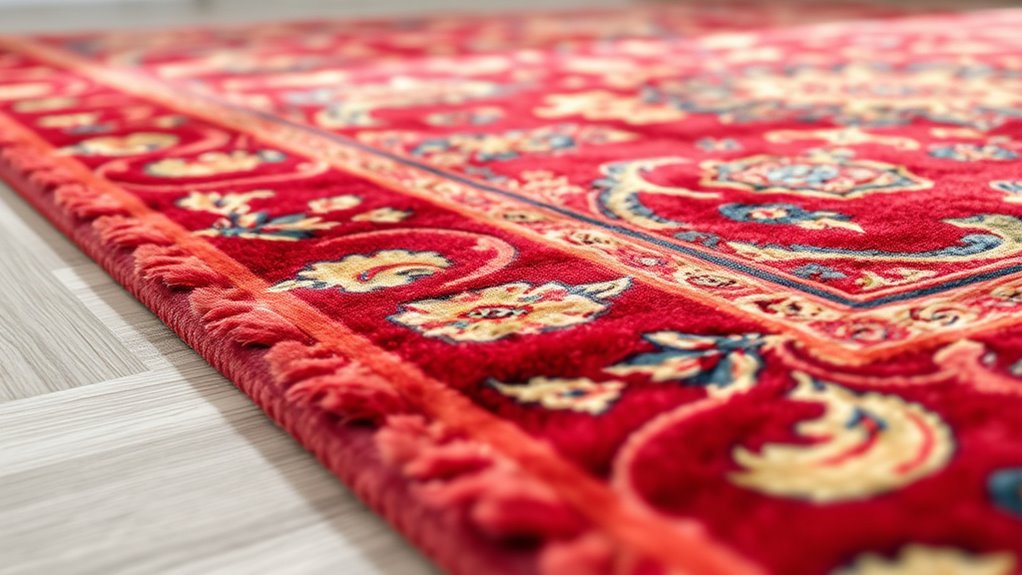
Before you start photographing your rug, it’s essential to give it a thorough cleaning and inspection. Material durability varies depending on its fiber, so follow the care instructions carefully to avoid damage. Check for stains, loose threads, or signs of wear that could detract from its appearance in photos. Clean the rug according to its specific care instructions—whether that’s vacuuming, spot cleaning, or professional cleaning. Removing dust and debris ensures a clearer, more appealing image. Inspect for any damages or irregularities that might need repair before photographing. A well-maintained rug not only looks better but also conveys quality to potential buyers. Additionally, choosing the right color accuracy can help in capturing the true hues and details of your rug during the shoot. Recognizing the material type of your rug can guide you in selecting the most suitable cleaning and care methods. Taking these preparatory steps helps showcase your rug’s best features and boosts its appeal in online listings.
Choosing the Right Lighting Conditions
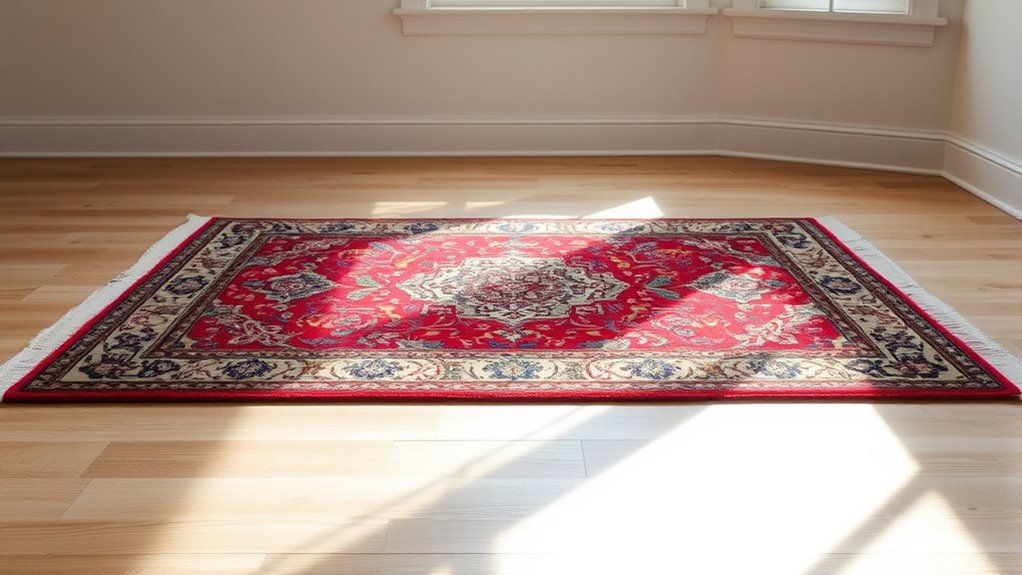
Once your rug is clean and ready, the next step is to focus on lighting. Good lighting minimizes ambient shadows that can distort the rug’s appearance and ensures accurate color representation. Natural daylight is ideal because it provides a balanced color temperature, helping the true hues of your rug stand out. If shooting indoors, aim for soft, diffused light from windows or use daylight-balanced bulbs. Avoid harsh, direct lighting that creates strong shadows or uneven highlights. Consistent, even lighting shows off the rug’s details and texture without misleading the viewer. Adjust your light sources to eliminate unwanted shadows and maintain a neutral color temperature. Proper lighting makes your rug look appealing, true to life, and ready for online resale. Using lighting techniques can further enhance the overall appearance of your photographs. Additionally, incorporating AI-powered lighting tools can help optimize exposure and color balance for a professional look. Being aware of headphone jack types can also be useful when choosing portable lighting equipment or accessories for your setup. Paying attention to local store hours might also help you plan your shopping for lighting accessories more efficiently.
Selecting the Best Background and Setting
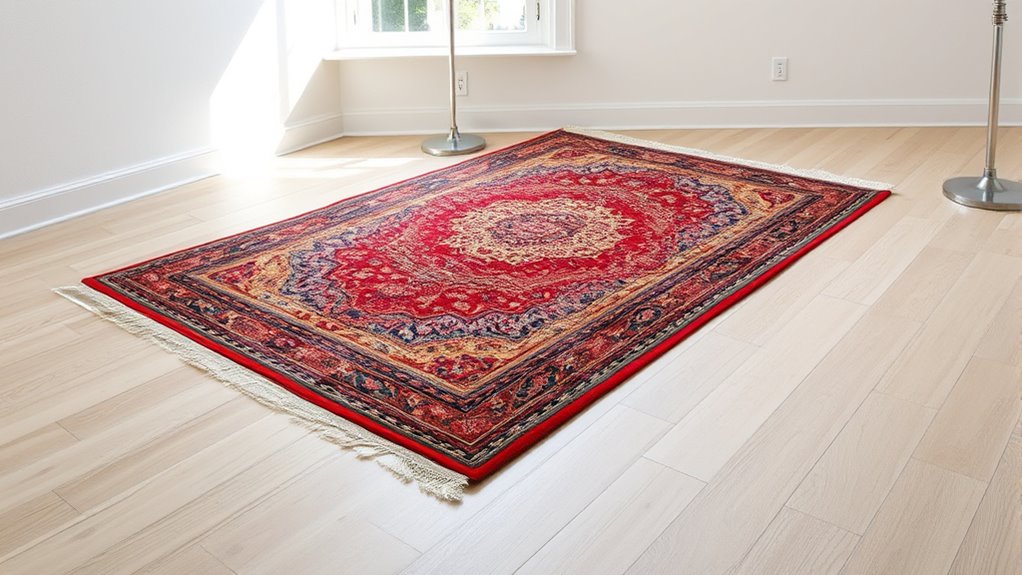
Choosing the right background and setting can profoundly enhance your rug’s visual appeal in photos. A well-chosen backdrop highlights the rug’s color contrast and material texture, making it more attractive to buyers. Ideally, select neutral tones like white, gray, or beige to avoid clashing with your rug’s colors. Avoid busy patterns that distract from the rug itself. To help you visualize, here’s a quick guide:
| Background Color | Material Texture | Best Use Case |
|---|---|---|
| White | Smooth | Clean, modern look |
| Gray | Matte | Emphasizes subtle details |
| Beige | Slightly textured | Warmer, cozy feel |
| Solid Colors | No pattern | Highlights vibrant or intricate designs |
Creating an organized and clutter-free space can significantly improve your photography environment, ensuring the focus remains on the rug’s features. Additionally, incorporating elements of rustic decor can enhance the farmhouse aesthetic in your photos, making them more appealing to potential buyers. Incorporating lighting techniques can further highlight the rug’s texture and colors, resulting in more compelling images. Properly timed natural light or studio lighting setups can also improve the overall quality of your photographs.
Using a Suitable Camera or Smartphone
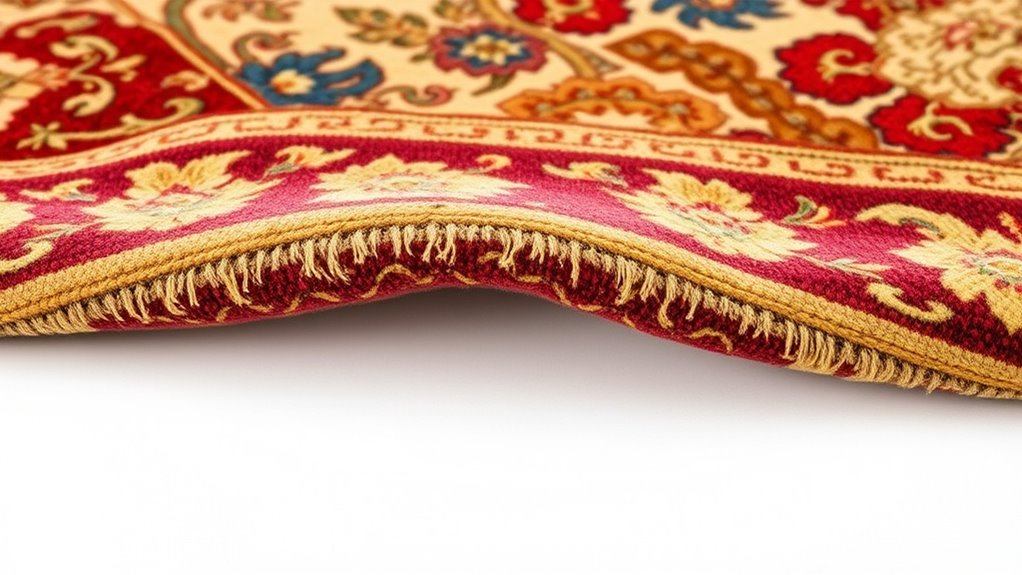
To get great rug photos, you need to choose the right camera or smartphone and set it up properly. Pay attention to your lighting conditions, as good light makes a huge difference. Also, consider your smartphone’s lens options or camera settings to capture the details and colors accurately. Incorporating visual imagery from nature or literature can inspire better composition and make your photos more engaging. Utilizing lighting techniques can further enhance the clarity and appeal of your images, ensuring your rugs stand out effectively. Being aware of essential oils for photography can also help create a calming environment, improving your focus and creativity during the shoot. Additionally, selecting the appropriate filter types can help refine your photos and highlight the rug’s features.
Camera Settings Optimization
When photographing rugs, optimizing your camera or smartphone settings is essential to capture their details and colors accurately. Start by adjusting color calibration to ensure the rug’s true hues are represented, avoiding overly warm or cool tones. Set your camera or smartphone to the highest image resolution available, so every pattern and fiber detail is sharp and clear. Use the manual or pro mode if possible, allowing you to control exposure, ISO, and focus precisely. Keep the ISO low to reduce grain, and choose a narrow aperture for greater depth of field. These adjustments help produce high-quality images that highlight the rug’s texture and color accuracy, making your online listing more appealing and trustworthy to potential buyers. Additionally, understanding the importance of image quality can help you prioritize settings that enhance your photos’ clarity and appeal. Paying attention to lighting conditions and energetic alignment with your environment can further elevate your photos by creating a more harmonious and vibrant presentation. Incorporating camera settings optimization techniques, such as adjusting white balance and exposure, can further improve the authenticity of your rug photographs. Being aware of potential vulnerabilities in AI technology can also guide you to use reliable editing tools that preserve the natural appearance of your images.
Lighting Conditions Matters
Lighting conditions play a crucial role in capturing the true beauty of your rugs, so make sure you have plenty of natural light or well-placed artificial lighting. Good lighting reveals the fiber types and highlights the dyeing techniques used, guaranteeing potential buyers see the rug’s quality. To optimize your photos:
- Use diffuse natural light from windows to minimize shadows and color distortion.
- Avoid harsh midday sun that can wash out details.
- If using artificial lights, ensure even coverage with neutral-colored bulbs to accurately represent the rug’s colors and fiber textures.
- Incorporating proper lighting techniques aligned with lifestyle principles can also reduce stress and improve your overall experience when photographing your rugs.
Proper lighting helps showcase the depth of the dyeing techniques and the richness of fiber types, making your rug more appealing and true to life. This attention to lighting ensures your online photos attract confident buyers.
Smartphone Lens Choices
Choosing the right lens or camera for your rug photos can make a significant difference in capturing their details and true colors. If you’re using a smartphone, opt for a device with a high-quality camera and consider using a macro or portrait lens attachment to highlight intricate patterns and textures. For vintage charm rugs, close-up shots with a smartphone lens help emphasize aged details and faded hues. To ensure your images are sharp and clear, consider adjusting your camera settings for optimal focus and exposure. For modern styles, wider-angle lenses ensure you capture the entire rug’s design in a clean, sharp image. Avoid digital zoom, which can reduce quality. Instead, get close or crop later. Good lens choices help showcase the rug’s authenticity, whether it’s a vintage piece or a sleek, contemporary design, enticing buyers with vivid, accurate images. Additionally, selecting noise levels that are low on your camera or smartphone can prevent distracting graininess in your photos, resulting in clearer, more appealing images. Incorporating proper lighting conditions further enhances color accuracy and detail, making your rugs stand out in online listings.
Framing the Rug for Maximum Impact
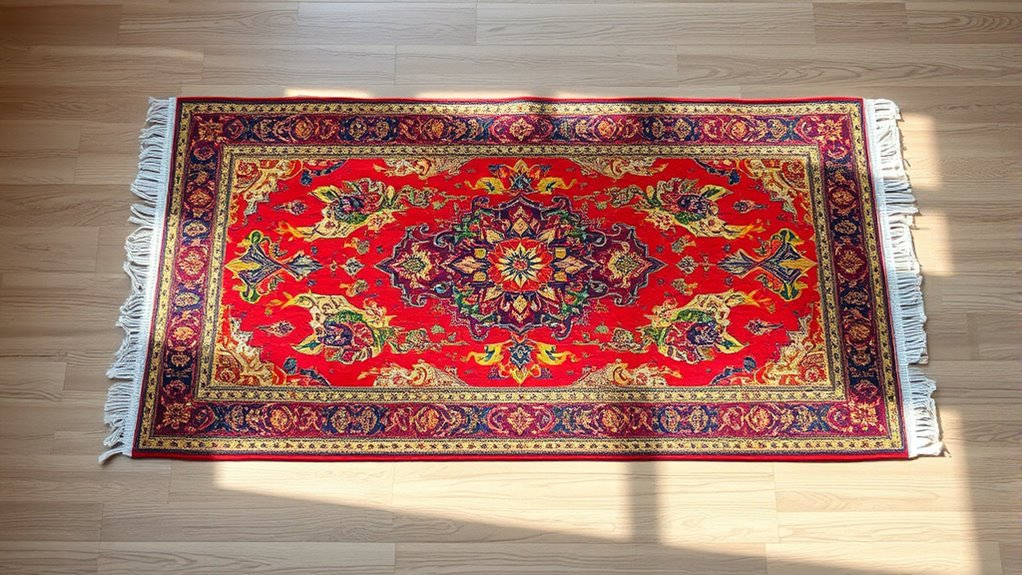
To showcase your rug’s beauty, framing is essential for creating maximum impact in your photograph. Start by ensuring the rug is level and straight to emphasize pattern symmetry, which draws the viewer’s eye. Use these three tips:
- Position the rug to highlight strong color contrast, making the colors pop and catch attention.
- Frame the shot to keep the entire rug within the edges, emphasizing its symmetry and design flow.
- Avoid cutting off key pattern elements; include enough space around the rug to showcase its full design and balance.
Capturing Close-Up Details of Patterns and Textures
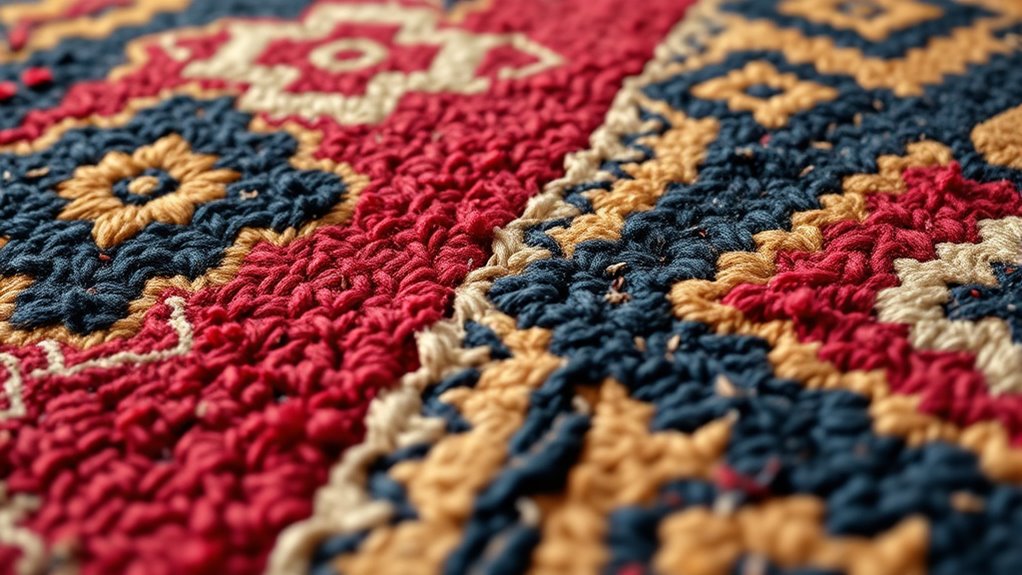
Focusing on close-up shots allows you to showcase the rug’s intricate patterns and rich textures. Pay attention to the fine details that make each rug unique, from delicate motifs to raised fibers. By emphasizing these elements, your photos will truly capture the rug’s craftsmanship and character.
Highlighting Pattern Intricacies
Capturing the intricate patterns and textures of a rug requires getting up close and paying attention to the fine details. Focus on highlighting key features that demonstrate quality, such as:
- Use macro shots to emphasize pattern symmetry, showcasing how elements align perfectly.
- Adjust your lighting to enhance color contrast, making the design’s hues pop and revealing subtle variations.
- Zoom in on areas with complex motifs or textures to display craftsmanship, ensuring potential buyers see the rug’s detail and intricacy.
Emphasizing Texture Details
When photographing rugs, emphasizing texture details brings their depth and craftsmanship to life. Focus on close-up shots that highlight weaving techniques and dyeing methods, revealing the rug’s intricate craftsmanship. Use a macro lens or a camera with a good zoom to capture the tactile qualities of the fibers, showing how different weaving techniques create patterns and textures. Lighting plays a key role; side lighting accentuates ridges and pile heights, emphasizing texture. Consider the dyeing methods, capturing variations in color and how they interact with the weave. Below is a visual guide to texture details:
| Texture Element | Technique | Visual Effect |
|---|---|---|
| Pile Height | Close-up of pile fibers | Shows plushness or flatness |
| Weaving Density | Tight vs. loose weave | Highlights craftsmanship |
| Dye Variations | Faded vs. vibrant colors | Demonstrates dyeing methods |
| Surface Relief | Raised patterns or knots | Adds visual depth |
| Fiber Types | Wool, silk, cotton details | Reveals material quality |
Shooting From Multiple Angles
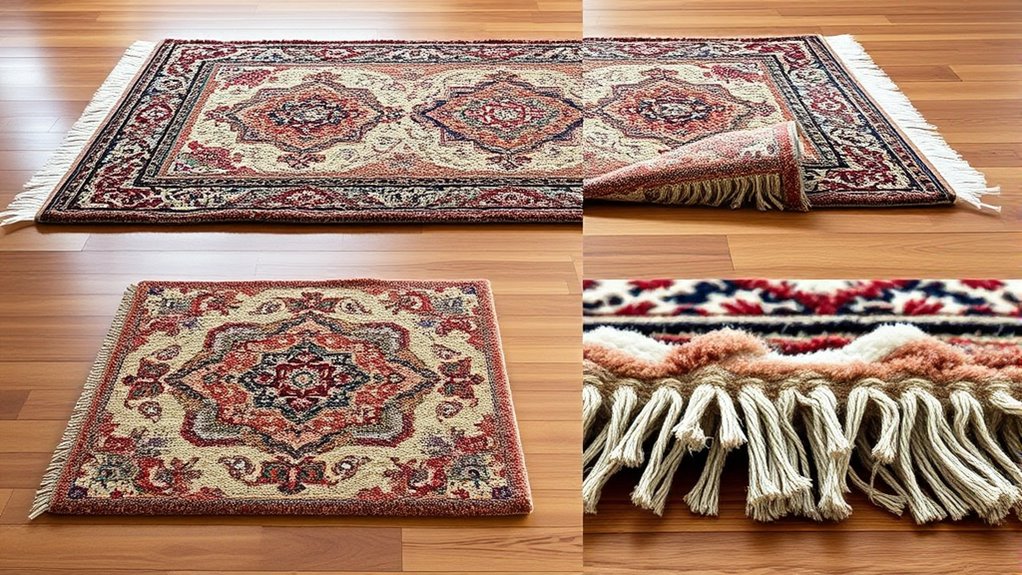
To truly showcase the beauty and detail of a rug, photographing it from multiple angles is essential. This approach helps buyers see the full scope of the design and craftsmanship. Start with these key shots:
- Top-down view: Guarantee proper color calibration to represent the true hues, and use balanced lighting for accurate photo composition.
- Side angles: Capture the rug’s thickness and texture, giving a sense of depth.
- Close-ups: Highlight intricate patterns and fiber details to attract detail-oriented buyers.
Avoiding Glare and Reflections
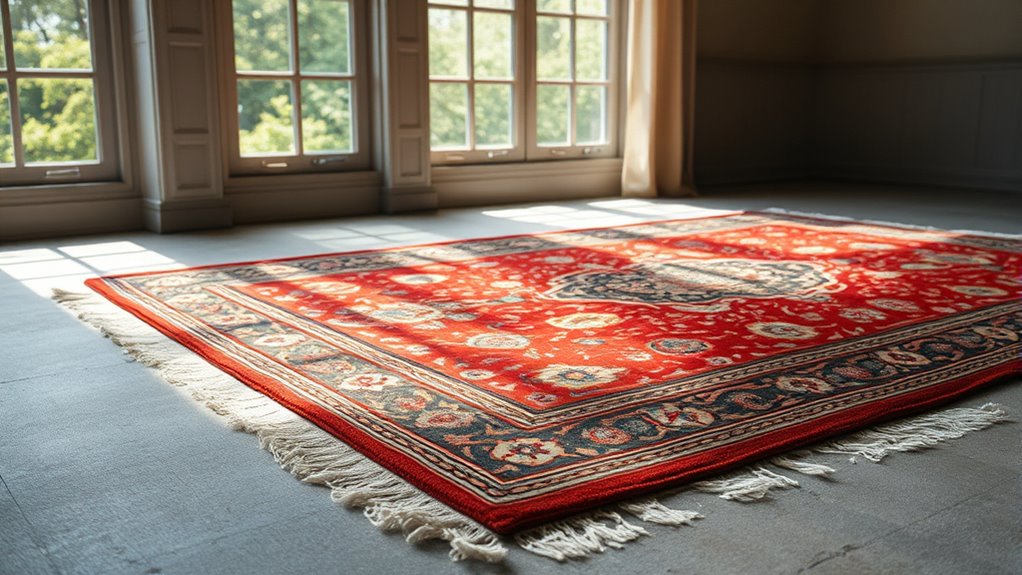
To prevent glare and reflections, you should carefully control your lighting setup, positioning lights to minimize direct reflections on the rug’s surface. Using polarizing filters can also help reduce unwanted glare when shooting through glass or shiny textures. Experimenting with both techniques will give you the best results for clear, true-to-life images.
Lighting Control Techniques
Controlling lighting is essential for avoiding glare and reflections that can obscure the details of a rug. To achieve this, focus on managing ambient shadows and light diffusion. First, position your lights at an angle to the rug to minimize direct reflections. Second, use diffusers or softboxes to spread light evenly, reducing harsh spots. Third, adjust your light intensity to avoid hotspots that create glare. These techniques help soften ambient shadows and promote even illumination, revealing intricate patterns without unwanted shine. By carefully regulate light direction and diffusion, you ensure your rug’s colors and textures are accurately represented. This approach creates a balanced, glare-free image that highlights your rug’s best features for online resale.
Using Polarizing Filters
Using polarizing filters is an effective way to reduce glare and reflections when photographing rugs. These filters help control unwanted reflections from shiny surfaces, ensuring your rug’s colors appear true and vibrant. By rotating the filter, you can achieve better color correction, making details stand out without overexposing areas or creating lens flare. Polarizers also minimize reflections from glass or glossy finishes, giving a clearer view of the rug’s texture and pattern. This results in more accurate online listings that attract buyers. Be mindful that excessive use can darken your image slightly, so adjust your exposure accordingly. Overall, a polarizing filter enhances your photos by eliminating distracting glare, improving color accuracy, and delivering professional-looking images for your online resale platform.
Editing Photos for Brightness and Color Accuracy
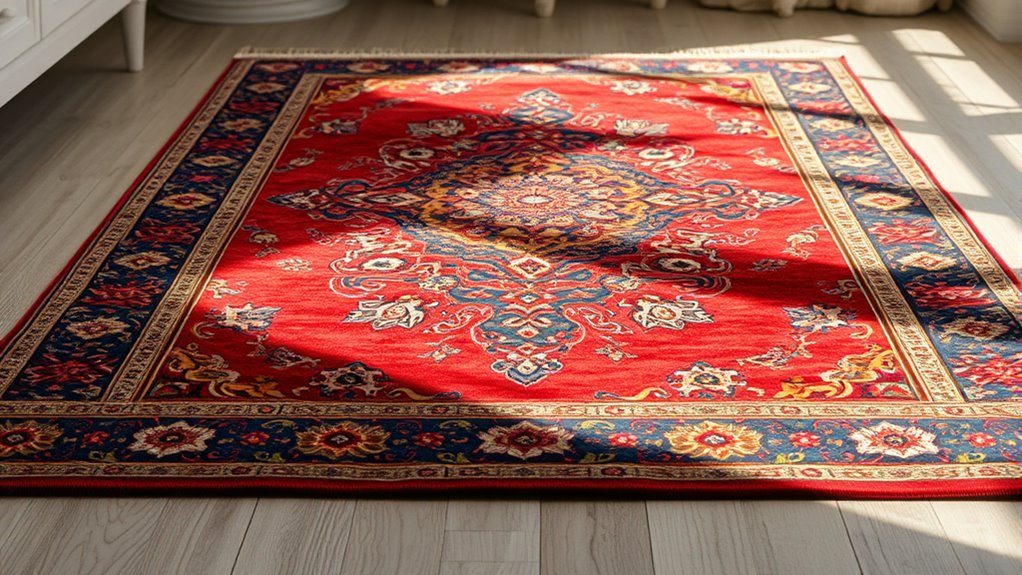
Adjusting the brightness and color accuracy of your rug photos guarantees that the images truly reflect the actual appearance of the textiles. Proper photo editing ensures potential buyers see the rug’s true colors and details. To achieve this, focus on three key steps:
- Use photo editing software to adjust brightness and contrast, making the image clear without overexposing or underexposing.
- Perform color correction to balance hues, ensuring the rug’s colors are true to life.
- Zoom in and refine details to highlight texture and pattern, enhancing visual appeal.
These steps help create accurate, eye-catching images that build trust and increase sales. Remember, consistent editing improves your online presence and showcases your rugs authentically.
Showcasing the Rug in Context With Scale
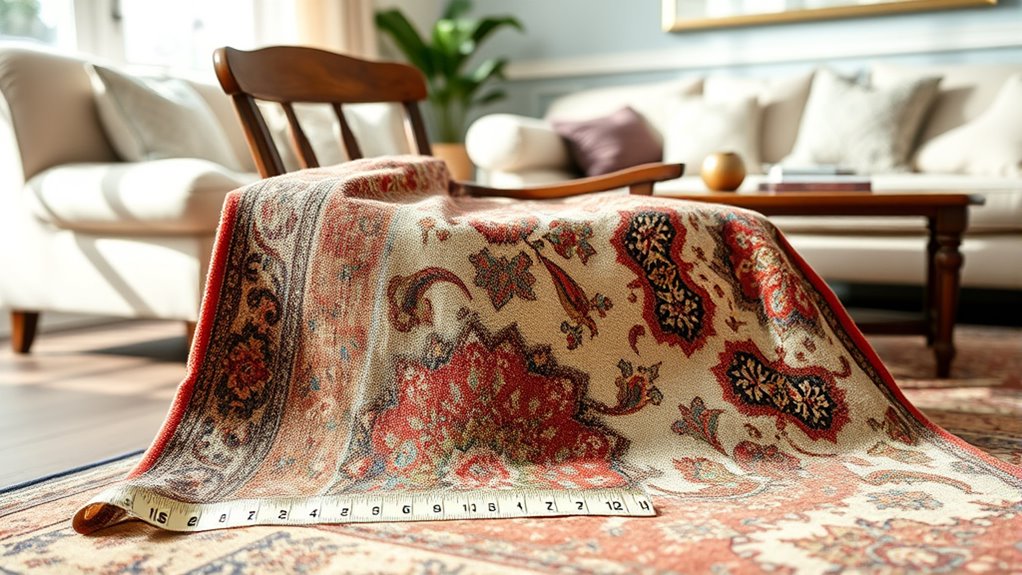
After perfecting your rug photos through editing, the next step is to show viewers how the rug fits into a real space. This involves providing a clear scale comparison and room context, helping buyers visualize the size and placement. Use wide-angle shots that include furniture or other familiar objects to demonstrate the rug’s proportions. Incorporate natural elements like a sofa, coffee table, or chairs to give a sense of scale. Avoid isolated close-ups; instead, showcase the rug as part of a complete room scene. This approach makes it easier for potential buyers to imagine the rug in their own space, reducing uncertainty about size and enhancing appeal. Accurate scale comparison and room context are key to convincing online shoppers.
Frequently Asked Questions
How Can I Ensure Consistent Color Representation Across Different Devices?
To guarantee consistent color representation across devices, you should focus on color calibration and device profiling. Regularly calibrate your monitors with a color calibration tool to maintain accurate colors. Use device profiling software to create profiles tailored to each device you view images on. This way, you can compare colors more reliably and ensure your rug photos look consistent, no matter what device your customers or viewers use.
What Accessories Can I Use to Enhance Rug Photographs?
Think of your rug photo as a curated space; accessories like throw pillows and decorative trays can bring it to life. Use these items to add context and scale, making the rug inviting. I once styled a living room shot with vibrant pillows and sleek trays, which made the rug pop. These accessories not only enhance visual appeal but also help customers envision the rug in their own homes.
How Do I Photograph Rugs With Intricate or Shiny Patterns Without Glare?
To photograph rugs with intricate or shiny patterns without glare, you should use lighting techniques that diffuse light, such as softboxes or bounce cards. Avoid direct flash and position your light source at an angle to minimize reflections on reflective surfaces. Adjust your camera’s angle and use polarizing filters if needed. These steps help you capture detailed, glare-free images that highlight the rug’s beauty effectively.
What Are the Best Practices for Photographing Large or Heavy Rugs?
When photographing large or heavy rugs, you should use wide-angle lenses and tripods with your camera equipment to capture the entire piece clearly. Adjust your lighting techniques to evenly illuminate the rug without creating shadows or glare, using diffused light sources. Position yourself to shoot from multiple angles, ensuring the entire rug is visible and well-lit. This approach helps showcase details and texture, making your online listing more appealing.
How Can I Create a Sense of Texture and Depth in Flat-Lay Photos?
To create a sense of texture and depth in flat-lay photos, you should use strategic lighting techniques, like side lighting, to cast gentle shadows that highlight surface details. Choose angles that emphasize the rug’s patterns and textures, such as a slightly angled shot rather than directly overhead. Experiment with different lighting and angles until you capture the rug’s richness, making it visually appealing and true to its feel.
Conclusion
Now that you know how to photograph rugs for online resale, you’re ready to showcase their beauty and attract buyers. By paying attention to lighting, angles, and editing, you’ll make your rugs stand out. Remember, isn’t it worth capturing their true charm to make that sale? With these tips, you’ll turn your photos into irresistible listings, helping your rugs find new homes quickly and easily. Happy photographing!
